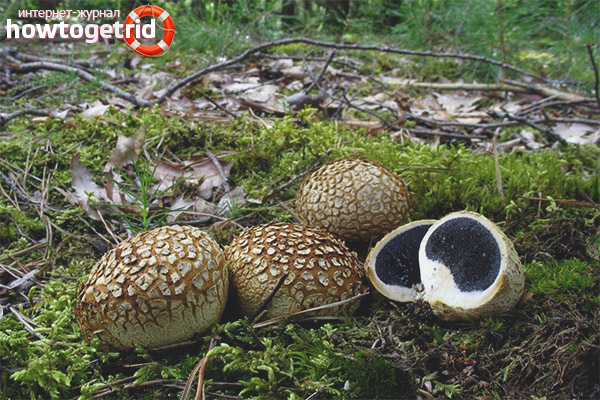The content of the article
The common raincoat belongs to the group of the fungus family. The mushroom has a lot of different names. In scientific works, pseudo raincoat is known as "scleroderma". This literally translates from Latin as "thick skin." Scientists call mycologists a false raincoat, a false raincoat orange or a false raincoat lemon. This name of the fungus needs no explanation, as it speaks for itself - the fungus is not a real raincoat. Experienced mushroom pickers often use such names as "damn tobacco", "hare potato" or "dust maker" to denote this mushroom.
For a long time, this fungus was considered a member of the same family along with an edible raincoat. Over time, mycologists have proven that these two representatives of the kingdom of mushrooms have completely different distinctive features. This made it possible to attribute these two types of fungus to different families.
The false raincoat or scleroderma orange has a rather tasteless inside, the mushroom itself has a characteristic unpleasant aroma. The smell of pulp of young mushrooms resembles the taste of raw potatoes, but too mature mushrooms have an unbearable aroma. Scientists classify a puddle raincoat as a class of inedible mushrooms, so it is not recommended for use in cooking. If you eat a lot of these mushrooms, then a person can go to the hospital with food poisoning.
Characteristics of a false raincoat
The false raincoat is ranked among the mushrooms as gastromycetes, which indicates a rather closed structure of its fruiting body. The fungus forms deep in the soil and only then appears on the surface for ripening. After a false raincoat is shown on the surface, it begins to acquire a spherical shape in the form of a tuber.
The fruit body of a young puddle rain is coated externally with a smooth shell having a characteristic milky or white color. As the fungus ripens, this surface shell becomes dark and rough. In more mature mushrooms, the outer shell has a dense, leathery, scaly surface with a characteristic dirty yellow or reddish hue. Due to such characteristic features and dense skin, the raincoat is false and got its name "scleroderma". On average, the thickness of the shell of a false raincoat can vary between 2 - 4 millimeters.
The inside of the false raincoats also has a characteristic dense, fleshy and slightly stiff flesh. As they mature, the spores of the fungus acquire a dark shade and even become purple-black over time. But young representatives of this variety of mushrooms have a whiter flesh inside. Mushrooms, slightly ripened, become marble in the section, and overripe ones acquire a dark color of pulp. Later, in an old mushroom, the flesh is transformed into a powder of brown or olive shade, and the shell itself from above begins to break into different sized areas. Thus, at the top - in the region of the crown, the fungus forms a hole with which it throws out spores.
Where do false raincoats grow?

False raincoats usually develop coniferous and deciduous forests. Here they grow most widely. Mushroom pickers often encounter these inedible mushrooms at the edge of the forest or along the road. They usually grow on land with loamy or clay soil. Inexperienced mushroom pickers are often confused with puddles ordinary with raincoats. However, it is important to remember that false raincoats usually grow in groups, while real raincoats settle alone in the forest area.
Are common puddles edible?
False raincoats are considered an inedible variety of mushrooms. The fact is that the flesh of the puddle rain emits an unpleasant bitterness, which spoils the taste of this mushroom. In addition, the dark unaesthetic color and the unpleasant aroma of the inside of the mushrooms instantly scare away potential mushroom pickers from false raincoats.
However, some lovers still believe that in small doses these mushrooms can be used, for example, add two or three segments of the mushroom to the dish, which will give it the smell of truffles. It is important to remember that a small amount of phytotoxin is concentrated inside the fungus. This substance can cause a person’s gastrointestinal upset or food poisoning.
Basically, false raincoats are used for medical purposes for the treatment of diseases with folk remedies. The thing is that the substance calvacin, which is contained in the core of the false raincoat, has a therapeutic effect and can help in the fight against some diseases. In folk medicine, false raincoats are used in the treatment of cancer, with dermatological problems in patients, and are used for cuts, wounds and other skin lesions.
Video: false raincoat (Scleroderma aurantiacum)










Submit